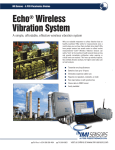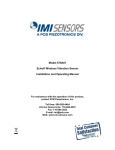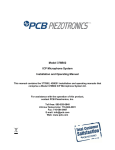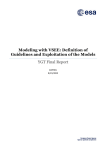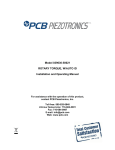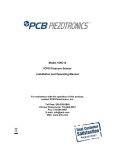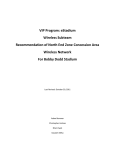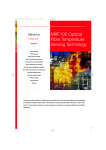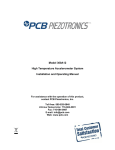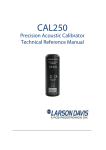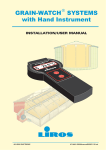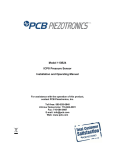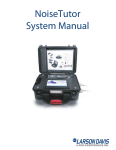Download Model 673A01 Echo® Wireless Receiver Installation
Transcript
Model 673A01 Echo® Wireless Receiver Installation and Operating Manual For assistance with the operation of this product, contact PCB Piezotronics, Inc. Toll-free: 800-959-4464 24-hour SensorLine: 716-684-0001 Fax: 716-684-3823 E-mail: [email protected] Web: www.imi-sensors.com Warranty, Service, Repair, and Return Policies and Instructions The information contained in this document supersedes all similar information that may be found elsewhere in this manual. Total Customer Satisfaction – PCB Piezotronics guarantees Total Customer Satisfaction. If, at any time, for any reason, you are not completely satisfied with any PCB product, PCB will repair, replace, or exchange it at no charge. You may also choose to have your purchase price refunded in lieu of the repair, replacement, or exchange of the product. Service – Due to the sophisticated nature of the sensors and associated instrumentation provided by PCB Piezotronics, user servicing or repair is not recommended and, if attempted, may void the factory warranty. Routine maintenance, such as the cleaning of electrical connectors, housings, and mounting surfaces with solutions and techniques that will not harm the physical material of construction, is acceptable. Caution should be observed to insure that liquids are not permitted to migrate into devices that are not hermetically sealed. Such devices should only be wiped with a dampened cloth and never submerged or have liquids poured upon them. Repair – In the event that equipment becomes damaged or ceases to operate, arrangements should be made to return the equipment to PCB Piezotronics for repair. User servicing or repair is not recommended and, if attempted, may void the factory warranty. Calibration – Routine calibration of sensors and associated instrumentation is recommended as this helps build confidence in measurement accuracy and acquired data. Equipment calibration cycles are typically established by the users own quality regimen. When in doubt about a calibration cycle, a good “rule of thumb” is to recalibrate on an annual basis. It is also good practice to recalibrate after exposure to any severe temperature extreme, shock, load, or other environmental influence, or prior to any critical test. PCB Piezotronics maintains an ISO9001 certified metrology laboratory and offers calibration services, which are accredited by A2LA to ISO/IEC 17025, with full traceablility to N.I.S.T. In addition to the normally supplied calibration, special testing is also available, such as: sensitivity at elevated or cryogenic temperatures, phase response, extended high or low frequency response, extended range, leak testing, hydrostatic pressure testing, and others. For information on standard recalibration services or special testing, contact your local PCB Piezotronics distributor, sales representative, or factory customer service representative. Returning Equipment – Following these procedures will insure that your returned materials are handled in the most expedient manner. Before returning any equipment to PCB Piezotronics, contact your local distributor, sales representative, or factory customer service representative to obtain a Return Materials Authorization (RMA) Number. This RMA number should be clearly marked on the outside of all package(s) and on the packing list(s) accompanying the shipment. A detailed account of the nature of the problem(s) being experienced with the equipment should also be included inside the package(s) containing any returned materials. PCB for a complete statement of our warranty. Expendable items, such as batteries and mounting hardware, are not covered by warranty. Mechanical damage to equipment due to improper use is not covered by warranty. Electronic circuitry failure caused by the introduction of unregulated or improper excitation power or electrostatic discharge is not covered by warranty. A Purchase Order, included with the returned materials, will expedite the turn-around of serviced equipment. It is recommended to include authorization on the Purchase Order for PCB to proceed with any repairs, as long as they do not exceed 50% of the replacement cost of the returned item(s). PCB will provide a price quotation or replacement recommendation for any item whose repair costs would exceed 50% of replacement cost, or any item that is not economically feasible to repair. For routine calibration services, the Purchase Order should include authorization to proceed and return at current pricing, which can be obtained from a factory customer service representative. Contact Information – International customers should direct all inquiries to their local distributor or sales office. A complete list of distributors and offices can be found at www.pcb.com. Customers within the United States may contact their local sales representative or a factory customer service representative. A complete list of sales representatives can be found at www.pcb.com. Toll-free telephone numbers for a factory customer service representative, in the division responsible for this product, can be found on the title page at the front of this manual. Our ship to address and general contact numbers are: Warranty – All equipment and repair services provided by PCB Piezotronics, Inc. are covered by a limited warranty against defective material and workmanship for a period of one year from date of original purchase. Contact DOCUMENT NUMBER: 21354 DOCUMENT REVISION: B ECN: 17900 PCB Piezotronics, Inc. 3425 Walden Ave. Depew, NY 14043 USA Toll-free: (800) 828-8840 24-hour SensorLineSM: (716) 684-0001 Website: www.pcb.com E-mail: [email protected] Echo® Wireless Receiver User’s Manual Model 673A01 52439 REV. A ECN#: 40574 Table of Contents FCC NOTICE ..................................................................................................................... 3 FCC ID: ZOC-IMI673A01 ............................................................................................. 3 INDUSTRY CANADA (IC) NOTICE............................................................................... 3 IC: 9732A-IMI673A01 ................................................................................................... 3 Introduction......................................................................................................................... 4 Proper Handling .................................................................................................................. 4 Receiver Connections ......................................................................................................... 5 Connection A – MIL Connector ..................................................................................... 6 Connection B – Waterproof Ethernet ............................................................................. 6 Connection C – N Antenna Connection.......................................................................... 6 Locating and Installing the Receiver .................................................................................. 7 Programming the Receiver ................................................................................................. 8 Setting a Static or Dynamic IP Address.......................................................................... 8 2 FCC NOTICE FCC ID: ZOC-IMI673A01 This device complies with part 15 of the FCC Rules. Operation is subject to the following two conditions: (1) This device may not cause harmful interference, and (2) this device must accept any interference received, including interference that may cause undesired operation. Changes or modifications not expressly approved by the party responsible for compliance could void the user's authority to operate the equipment. This equipment has been tested and found to comply with the limits for a Class A digital device, pursuant to part 15 of the FCC Rules. These limits are designed to provide reasonable protection against harmful interference when the equipment is operated in a commercial environment. This equipment generates, uses, and can radiate radio frequency energy and, if not installed and used in accordance with the instruction manual, may cause harmful interference to radio communications. Operation of this equipment in a residential area is likely to cause harmful interference in which case the user will be required to correct the interference at his own expense. INDUSTRY CANADA (IC) NOTICE IC: 9732A-IMI673A01 Operation is subject to the following two conditions: (1) this device may not cause interference, and (2) this device must accept any interference, including interference that may cause undesired operation of the device. 3 Introduction The Echo® Receiver is a one-way wireless communication receiver operating in the 902928 MHz unlicensed ISM Band. Using exclusive Extended Range RF technology, it receives wirelessly transmitted vibration data from Echo® Wireless Vibration Sensors and EchoPlus® Wireless Junction Boxes. It outputs the data to a computer or server running Echo® Monitoring Software through a standard Ethernet connection. The data is stored in a Microsoft® SQL database and can be displayed with the Echo® Data Presentation portion of the Echo® Monitoring software. For details on system and software installation, see the Echo® Wireless Vibration System Reception Survey and Installation Manual and the Echo® Monitoring Software User’s Manual. Proper Handling Proper handling and location of the Echo® Receiver is critical to correct operation and preventing damage. The box is rated at MIL-STD-810, Method 506.4 Procedure I and MIL-STD-810, Method 510.4 Procedures I and II. While it can be used in areas where there is some contact with water and the elements, it is not recommended that it be placed in an area where it will be subjected to heavy sprays or harsh weather. The receiver has an operating temperature range of -25° to +120° F (-32° to +49° C). Exposure to temperatures outside of this range may result in incorrect operation. It has a storage temperature range of -28° to +160° F (-33° to +71° C). Exposure to temperatures outside this range may result in damage to the electronic circuits. Warning: Do not attempt to remove the cover of the Echo® Receiver. There are no customer serviceable components inside. Removing the cover will void the warranty. 4 Receiver Connections The Echo® Receiver is has 4 connectors and an LED mounted on the side of the unit, see photo below. There are two identical and interchangeable MIL style bayonet connectors for power and RS-232 (serial cable), one RJ-45 Waterproof Ethernet connector, and 1 Nfemale antenna connector. Labels for these connectors are found on the bottom of the receiver. Note: The MIL connectors can be used interchangeably for power or RS-232 serial interface. Note: The receiver requires an optional Model 009M201 Echo® Receiver Serial Cable to use the serial port on the receiver. Note: In order to be waterproof, a waterproof Ethernet cable with screw on connector must be used. Location A Connector Type MIL B RF-45, Waterproof Ethernet N-female C A B Function Power Cable or Serial Cable Network Cable Quantity 2 Antenna 1 C 1 A 5 Connection A – MIL Connector The use of the MIL connectors is completely interchangeable between power and the serial interface. These connectors are used for two purposes. The first is for powering the Receiver. The supplied power adaptor has a mating MIL connector. The power adapter requires 100 to 240 VAC, 47 – 63 Hz line power. It provides the receiver with 12VDC power. When power is connected to the receiver, the blue LED will illuminate indicating the unit is on. Warning: Do not apply line power directly to the receiver. Damage to the unit will occur. Caution: It is not recommended to use a different 12 VDC power source than the supplied adaptor. If you intend to use a 12 VDC power supply other than the one supplied, contact IMI for important information. The MIL connectors on the receiver are also used for programming and updating the Echo® Receiver. An optional Model 009M201 Echo® Receiver Serial Cable (RS232 to MIL connector) is required to connect the receiver to a computer. For specific information on how to program or update the receiver, consult the “Programming the Receiver” section of this manual. Connection B – Waterproof Ethernet The Ethernet connector is used to connect the receiver to a network or stand alone computer. Any standard Ethernet cable (not provided) can be used to connect the receiver to a network. However, an industrial grade waterproof Ethernet connector may also be used and may be a better choice for dirty industrial environments because the boot will provide some additional protection. Note: If you choose to connect the receiver output directly into a stand alone computer a crossover cable is recommend in place of a standard Ethernet cable. Connection C – N Antenna Connection The N connector is used for the antenna input. A small antenna with appropriate adaptors is supplied with the receiver. This antenna will allow you to conveniently get started with the system, run some tests, and check things out. Most applications, however, will require a higher gain antenna (not supplied) connected to the receiver with a low loss antenna cable (not supplied). For specific instructions on selecting, locating, and mounting a remote antenna, please refer to the Echo® Wireless Vibration System Reception Survey and Installation Manual. Note: It is recommended that a low loss antenna cable (-4 dB loss / 100 ft) be used with an external higher gain antenna. 6 Locating and Installing the Receiver The receiver must be located a near line power source and an Ethernet network connection. The antenna should be located centrally to the area of interest and up high. Typically, a 6dBi gain omnidirectional antenna (not provided) is a good choice, although circumstances may suggest something different, like a Yagi directional antenna. Use low loss antenna cable and keep the length as short as possible, typically less than 100 feet. A good strategy is to map out your facility and mark possible locations for the receiver(s). Based on the possible receiver locations and the required measurement point locations, run a reception survey in the plant to determine the optimal location(s) for the receiver(s). For detailed information on this process, see the Echo® Wireless Vibration System Reception Survey and Installation Manual. The receiver is included with mounting hardware that can be used to secure it in place. The receiver should be physically located where it can be accessed with the programming cable should settings need to be adjusted. You may use the short antenna provided with the receiver for testing, setup, and in cases were the sensors are close to the receiver. To improve the performance, a 6 dBi gain omnidirectional antenna is generally recommended. It should be mounted in an elevated location for the best performance. In some cases, use either a higher gain omnidirectional antenna (generally not to exceed 8 dBi) or a higher gain directional Yagi antenna. The antenna should be connected to the receiver using low loss antenna (-4 dB loss / 100 ft) 7 cable. For specific information consult the Echo® Wireless Vibration System Reception Survey and Installation Manual. Note: Proper location of the antenna can make a dramatic difference in system performance. Care should be given to determining the optimal locations for the receiver and antenna. Programming the Receiver The receiver can be programmed to a static or dynamic IP address and one of 12 independent RF frequency bands. Firmware updates can also be installed when available. The following equipment is required for programming the receiver: • • • • Echo® Receiver Power supply Receiver programming cable Computer with the Echo® Monitoring Software installed Setting a Static or Dynamic IP Address To check the status of the IP configuration, launch the Echo® Monitoring Software, click on Receiver Utilities, and then click Configure IP Address. Select the COM port the receiver programming cable is connected to. 8 To check the current settings in the receiver, click the Query Receiver button. A screen similar to the following will be displayed. 9 If the receiver is set to a Static IP address and you require dynamic addressing, click the Dynamic IP button then click Apply Update as shown below. 10 It is highly recommended to use the receiver with a static IP address. To do this, you will most likely need the assistance of your IT department. Enter the IP Address, Subnet Mask, and Default Gateway into the appropriate field as shown below, and then click on Apply Update. 11 It may take up to 30 seconds to reprogram the receiver. After it is programmed, a screen similar to the following will be displayed. After the receiver has been programmed, click on Quit to close the programming menu. 12 Echo® Wireless Vibration System Reception Survey and Installation Manual Table of Contents Introduction………………………………………….……………………………..……..3 Reception Survey Preparation……………………………………………….……………3 Antenna Location…………………………………………………………………………3 Sensors per Receiver………………………………………………………………………3 Plant Drawing……………………………………………………………………………..4 Install Software……………………………………………………………………………4 Equipment Setup……………………………………………………………….………….4 Receiver Setup…………………………………………………………………………….4 Live Data……………………………………………………………………….……..…..9 Running the Survey…………………………………………………………………..…..10 Antenna Placement…………………………..…………………………………….…….10 Baseline Measurement………………..………………………………………….………10 Collecting the Data………………………………………………………………………11 Permanent Installation…………………………………………………….……………..12 Antenna and Receiver……………………………………………………………………12 Echo® Sensors……………………………………………………………………...…….12 EchoPlus® Junction Boxes………………………………………………………...……..12 Echo® Data Server Software……………………………………………..………………13 Echo® Wireless Vibration System Reception Survey and Installation Manual Version 1.0, 2011-09-21 2 Introduction The Echo® Wireless Vibration System is used for unattended predictive maintenance and condition monitoring of plant equipment. Echo® Wireless Vibration Sensors and EchoPlus® Wireless Junction Boxes wake up periodically and transmit vibration data wirelessly to one or more Echo® Receivers that are connected to a network or directly to a computer. Vibration data are automatically compared against alarm values, machinery status displayed in an alarm panel, and alarm notifications sent vial email if desired. The data can be viewed, reported, and trended using the Echo® Data Server Software. This manual is intended to assist users with the initial installation of the Echo® Wireless Vibration System, including the determination of optimum antenna/receiver placement, and running a plant wireless reception survey. Specific instructions for setting up Echo® Wireless Vibration Sensors, EchoPlus® Wireless Junction Boxes, and Echo® Receivers can be found in their respective manuals. Reception Survey Preparation Antenna Location - Prior to installing the Echo® Wireless Vibration System, it is highly recommended that a wireless reception survey be run in your plant. This will help determine what coverage can be achieved in your plant and whether or not it can be covered with a single antenna and receiver. The distance between transmitters and receivers (sensors and junction boxes are transmitters) varies widely depending on the infrastructure in the plant. Typically, a 1000 to 2500 foot reception radius can be achieved although distances can be as low as 250 to 300 feet (e.g., through concrete walls) and as high as 1 to 2 miles in open areas, although these distances are less common. Since reception distance is specified as a radius from the antenna location, a central location will normally work better than corner location in a plant. If more than one antenna and receiver are used, locations can be distributed to give the best coverage. The Echo® System transmits and receives point-to-point; no repeaters, bridges, routers, gateways, nodes, or other intervening network devices are required. Sensors per Receiver - The factory default transmission interval (i.e., the time between measurements) for Echo® Sensors and EchoPlus® Junction Boxes is 8-hours or 3 times per day. At this collection interval, it is recommended that the number of sensors or channels be limited to 400 per receiver. This is based on a statistical analysis where transmitters are started in an “intelligent” manner (i.e., staggered), taking into account clock drift, and assuming no more than a 1% collision rate. That means that no more than 1% of the transmissions may be lost due to too many simultaneous transmissions. Depending on the plant conditions, this number could be better. If either more than 400 channels or more than 3 measurements are required per day, multiple receivers can be used. Keep in mind that 3 measurements per day is 90 measurements per month, which is about 90 times more often than most walk around PM programs. Sensors, junction boxes, and receivers have 12 programmable RF Bands. For a 5% collision rate, up to 2000 sensors can be assigned per receiver. Echo® Wireless Vibration System Reception Survey and Installation Manual Version 1.0, 2011-09-21 3 Plant Drawing - Obtain a plant drawing that includes some basic overall dimensions on it. If one is not available, make a sketch of the plant (a crude sketch will work if nothing better is available) and include some overall plant dimensions as best you can. Mark the areas on the drawing where equipment is located that needs to be monitored. Also mark on the drawing where Ethernet drops are available or could be located. Generally speaking, the antenna should be located in an elevated, central, open area for best reception. A low loss (1 dB per 25’) antenna cable will run from the antenna to the receiver. If possible, keep this run to 25’ or less to reduce losses, however, up to 100’ can be used if necessary. The receiver can be mounted at a convenient location but requires 120 VAC power and an Ethernet drop in reasonably close proximity. Sequentially number points on the drawing in the various areas of the plant where equipment is located to be monitored. Pick a couple of representative points in each area and select one in the “worse case” location of each area. These are the locations where a test transmission will be made to determine reception strength. This drawing will be used to map the receiver(s) coverage and create a reception map. Install Software - Install the Echo® Data Server Software on a laptop or other computer that can be moved around the plant. Using a moveable computer is the most efficient way to run a survey and gives you the ability to easily move the antenna and receiver around the plant to find optimum locations. This does not need to be the computer that will be used for the actual monitoring system. This installation will be used temporarily for the survey. A laptop computer with the receiver directly connected to it via its Ethernet port is a very convenient way to do this. See the Echo® Data Server User’s Manual for details on loading and operating the software. You will need administrative rights to load the software and will most likely require the help of your IT department. Alternatively, the software can be installed on a computer connected the local area network and the receiver connected to an Ethernet drop located in the plant, however, this is not recommended for the survey. Equipment Setup Receiver Setup - Power up the receiver and wait at least 1 ½ minutes for the receiver to boot up and initialize. Echo® Wireless Vibration System Reception Survey and Installation Manual Version 1.0, 2011-09-21 4 Launch the Echo® Data Server Software. You should see a screen similar to the one below. Connect the Model 009M201 Echo® Receiver Serial Cable (optional) between one of the Power/RS232 connectors on the receiver and an RS232 serial port on your computer. If you do not have an RS232 port you will need to install a USB to RS232 converter (not supplied). Also install an Ethernet cable between the receiver and your computer. Click on the Receiver Utilities on the menu bar. You should see a screen similar to the following, and then click on Configure IP Address. Echo® Wireless Vibration System Reception Survey and Installation Manual Version 1.0, 2011-09-21 5 You should see a screen similar to the following. Echo® Wireless Vibration System Reception Survey and Installation Manual Version 1.0, 2011-09-21 6 Select the correct Serial Port using the pull down box in the upper right hand corner of the screen. The Receiver Status Running box should change colors to green when the correct port is selected. The Current Configuration box should get filled in similar to that shown in the screen below. If the Current Configuration box does not fill in, then click on the Query Receiver button. Make a note of the IP address in the Current Configuration box. This is 169.254.100.100 in the sample screen below. Echo® Wireless Vibration System Reception Survey and Installation Manual Version 1.0, 2011-09-21 7 Enter the IP Address into the IP Address box on the main screen as shown below. Then click on the Connect button. The Connect button should illuminate green and change to Active indicating the connection has been successfully established. Additionally, the horizontal bar should also change from grey to green as shown below. Echo® Wireless Vibration System Reception Survey and Installation Manual Version 1.0, 2011-09-21 8 Live Data - Click on the Live Data button for the active receiver. You should see a screen similar to the following. Note, the columns displayed and the display order are user selectable. To adjust the columns, click on Configuration on the main screen menu bar and then select Data Display Preferences. This will open a window that allows both the selection of columns to display and the display order. See the Echo® Data Server Software User’s Manual for details. This screen will show any Echo® sensor or EchoPlus® junction box transmissions that are set to the same RF Band as the active receiver. This screen will be used for the reception survey. In the upper left hand corner of the display is a Noise value that updates every few seconds. This the ongoing noise floor of the RF band we are working in. Under ideal background noise condition, this number should reach about -155 dBm. If the actual value is higher, then the systems maximum dynamic range is reduced somewhat but the system still works. In the example above, the Noise is -154.7 dBm so the background noise is a minimum. Echo® Wireless Vibration System Reception Survey and Installation Manual Version 1.0, 2011-09-21 9 Running the Survey Antenna Placement - Move the computer and receiver to the location to the first place in the plant that has been selected for the antenna. Use the antenna that is intended for permanent installation for the test. Do not use the small antenna supplied with the receiver unless the transmission distances are small and you intend to use it in your actual installation. In general, a 6 dBi gain antenna with a 10 to 25’ low loss cable is recommended for most installations, although an 8 dBi gain antenna may also be used. Contact IMI for additional information regarding antenna options. Connect the antenna cable between the receiver and antenna and temporarily place the antenna in an elevated location. Draping it over a pipe or beam will work well for this test. Baseline Measurement - It is highly recommended that the survey be run with a stand alone Echo® Wireless Vibration Sensor. Although it can be run with an EchoPlus® Wireless Junction Box, it will be a bit more difficult and time consuming. It will also be helpful if the sensor used for the survey is reprogrammed for a short transmission interval as shown in the screen below. Note: The transmission interval is programmable in 4 second increments. For details on programming Echo® sensors, see the Echo® Wireless Vibration Sensor Installation and Operation Manual. Echo® Wireless Vibration System Reception Survey and Installation Manual Version 1.0, 2011-09-21 10 Standing near the computer, activate the sensor with a fairly strong magnet as shown in the picture below. The LED will blink indicating that it is changing states, in this case, turning on. See the Echo® Wireless Vibration Sensor Installation and Operation Manual. Set the sensor down and move away from it so you don’t interfere with its transmission. The sensor will immediately make a measurement (solid blue LED) and then transmit it (solid bright blue LED). About three seconds after the bright LED goes off and if the system is setup and working correctly, an entry should appear on the top line of the Live Data spreadsheet, similar to the screen below. Write down the Average SNR (dB) value for that point. Record a couple of values for each point taken. Using the magnet, turn the sensor off. Note: If the LED has 4 seconds between blinks, it is on and waiting for the next transmission time. If the LED has 8-seconds between blinks, it is off and will not make any measurements until it is activated with a magnet. Collecting the Data - You will need two people to do the rest of the survey. One person to walk around the plant and activate the sensor at each point included in the survey in the same manner as described above. A second person will stay at the computer and log the results. A good process is for this is to use a radio or cell phone. In a noisy plant, a method that has proven to work well (if there is cell phone signal) is for the person with the sensor to text the point number to the person at the computer when they activate the sensor. The person at the computer then texts back the SNR, which acknowledges they got it and lets the walker know the strength of the signal. Echo® Wireless Vibration System Reception Survey and Installation Manual Version 1.0, 2011-09-21 11 The person viewing the Live Data should create a table, similar to that below, indicating if the data was received and the signal to noise ratio (SNR) at each location. In general, a signal to noise ratio greater than 20 dB is considered a strong signal. An example table is shown below. These values can also be added to the drawing to help get a visual of the coverage. Floor 1 1 2 2 2 3 Main Building Compressor Motor Drive Side Compressor Motor Opposite Drive Roller A Roller B Roller C Fan 6 Received Yes Yes Yes Yes Yes Yes SNR (dB) 34.103 34.337 30.958 23.056 27.6548 22.675 Distance (ft) 600 600 600 300 750 1200 This information can now be used to locate the receiver so that all points of interest are covered. If some points were not received, determine from your map if the receiver can be moved to another location that may improve results. If all points cannot be received with a single antenna location, other locations can be tested until suitable locations are found. In some cases, multiple receivers may be required to provide full coverage of the area of interest. Permanent Installation Antenna and Receiver - Once a suitable location for each receiver has been found the receiver can be permanently installed. The installation will require 120 VAC power and an Ethernet drop nearby. See the Echo® Receiver Installation and Operation Manual for details on installing the receiver. The antenna can be mounted using the hardware provided with the antenna. In general, it does not matter if the antenna is mounted vertically (up or down) or horizontally. If possible, keep the antenna cable length to 25’ or less. Echo® Sensors - Echo® Wireless Vibration Sensors are supplied with a ¼-28 mounting stud. It is highly recommended to stud mount the sensors. It is also recommended that each sensor be programmed at the same time the database monitoring point is setup prior to mounting. This will ensure that the sensor and database parameter for a monitoring point are the same. See the Echo® Wireless Vibration Sensor Installation and Operation Manual for details on setup and mounting. EchoPlus® Junction Boxes - EchoPlus® Wireless Junction Boxes can be installed in convenient locations near the ICP® Sensors they are associated with. It required either 24 VDC (recommended) or a battery pack supplying between 6 and 13 VDC. It is recommended that the junction box be programmed at the same time the database monitoring points are setup prior to mounting. This will ensure that the junction box and database parameter for a monitoring point are the same Please see the EchoPlus® Wireless Junction Box Manual for details on setup, installation, and mounting. Echo® Wireless Vibration System Reception Survey and Installation Manual Version 1.0, 2011-09-21 12 Echo® Data Server Software - It is highly recommended that the software be loaded on a server or dedicated computer on the network. The computer must run 24/7 to collect all data sent by the receiver(s). Please see the Echo® Data Server Software User’s Manual for specific instructions on installing the software and configuring the database. You will need administrative rights to do this and most likely, the help of your IT department. Manual – 52440 Revision – NR DIN - 38262 Echo® Wireless Vibration System Reception Survey and Installation Manual Version 1.0, 2011-09-21 13 Model Number Electrical Frequency Band Number of RF Bands RF Data Rate External DC Power(+12 VDC) Revision: NR ECHO® WIRELESS RECEIVER 673A01 ECN #: 38262 ENGLISH SI OPTIONAL VERSIONS 900 MHz ISM Band 12 20 bps 12 VDC 900 MHz ISM Band 12 20 bps 12 VDC Optional versions have identical specifications and accessories as listed for the standard model except where noted below. More than one option may be used. Physical Size (Height x Depth x Width) 2.1 in x 7.2 in x 8.4 in 53 mm x 183 mm x 213 mm Weight 3.76 lb 1.71 kg Housing Material Cast Aluminum Cast Aluminum All specifications are at room temperature unless otherwise specified. In the interest of constant product improvement, we reserve the right to change specifications without notice. Entered: DMW Engineer: NJF Sales: JMS Approved: NJF Spec Number: Date: 1/19/2012 Date: 1/19/2012 Date: 1/19/2012 Date: 1/19/2012 52019 3425 Walden Avenue, Depew, NY 14043 Phone: 800-959-4464 Fax: 716-684-3823 E-Mail: [email protected]






























